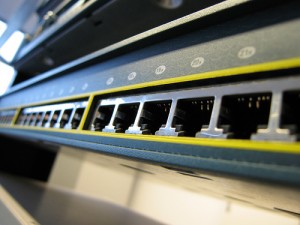
VLANs are a mechanism to allow network administrators to create logical broadcast domains that can span across a single switch or multiple switches, regardless of physical proximity. This function is useful to reduce the size of broadcast domains or to allow groups or users to be logically grouped without the need to be physically located in the same place.
One of the typical configuration activities you’ll perform on a Cisco Switch is to manipulate VLANs.
VLAN stands for Virtual Local Area Network.
In one physical Cisco Catalyst switch, you can create multiple VLANs that connects to different network.
For example, a VLAN for 10.10.191.0 network, a VLAN for 10.10.192.0 network, and a VLAN for 10.10.193.0 network. All three of these can be configured in the same physical switch.
While these commands were tested on a cisco catalyst switch 3750 series, similar commands (may be with slight variation to the port number format) should work on all cisco switches.
Create VLAN on Cisco Switch
If you are planning to have only one network in your whole switch (for example, 10.10.192.0). i.e. All the ports in the switch will be connected to the 10.10.192.0 network, then you don’t need to create a VLAN, just use the default VLAN 1.
Every switch comes with the default VLAN 1 as shown below. In this example, all the ports in this switch (from 1 through 8) are part of the default VLAN 1.
#show vlan
VLAN Name Status Ports
—- ——————————– ——— ————
1 default active Gi1/0/1, Gi1/0/2, Gi1/0/3, Gi1/0/4
Gi1/0/5, Gi1/0/6, Gi1/0/7, Gi1/0/8
In the following example, we are creating 192 VLAN network (for 10.10.192.0 network). While creating a VLAN you also need to specify the range of ports from the switch that needs to be part of this VLAN network.
In this example, ports 3 through 6 are configured as part of 192 VLAN network.
config t
vlan 192
interface range gigabitEthernet 1/0/3-6
switchport access vlan 192
exit
In the above commands:
- config t – Goes into the configuration mode
- vlan 192 – Creates VLAN 192
- interface range gigabitEthernet 1/0/3-6 – Indicates that the port numbers 3 through 6 are assigned to this VLAN
- swithport access vlan 192 – Indicates that the access to the vlan 192 is enabled
Apart from providing the access to the vlan 192 for the port numbers 3 through 6, you can also specify the following additional switchport configuration parameters (for example, nonegotiate and mode access)
config t
interface range gigabitEthernet 1/0/3-6
switchport mode access
switchport nonegotiate
exit
Once you’ve created a VLAN verify it as shown below,
#show vlan
VLAN Name Status Ports
—- ——————————– ——— ————
1 default active Gi1/0/1, Gi1/0/2, Gi1/0/7, Gi1/0/8
192 VLAN0192 active Gi1/0/3, Gi1/0/4, Gi1/0/5, Gi1/0/6
On a side note, it is always recommended that you upgrade ISO image on your cisco switch to the latest version.
Delete VLAN on Cisco Switch
You might want to delete a VLAN, if you are planning to switch the ports assigned to VLAN 192 to a different VLAN. Or, you might want to delete a VLAN, just because you’ve created it by mistake.
Let us assume that you want to delete the VLAN 192 (ports 3 through 6) that you just created.
Deleting a VLAN is as simple as assigning the default VLAN 1 to the ports that are part of the VLAN you want to delete, and delete the VLAN.
i.e If you want to delete VLAN 192, assign VLAN 1 to the ports 3 through 6, and just delete the VLAN 192.
First, assign the default VLAN 1 to ports 3 though 6 as shown below.
interface range gigabitEThernet 1/0/3-6
switchport access vlan 1
exit
Next, delete the vlan itself as shown below.
no vlan 192
Finally, verify that the VLAN 192 got deleted as shown below.
#show vlan
VLAN Name Status Ports
—- ——————————– ——— ————
1 default active Gi1/0/1, Gi1/0/2, Gi1/0/3, Gi1/0/4
Gi1/0/5, Gi1/0/6, Gi1/0/7, Gi1/0/8
As a final note, if you don’t know what you are doing, do not execute any of the above commands on production switch, as you might bring down your network. Do this only on a test system, where you can play around and learn how to manipulate VLANs on cisco switch.
More Related: Creating Ethernet VLANs on Catalyst Switches from Cisco’s official website



